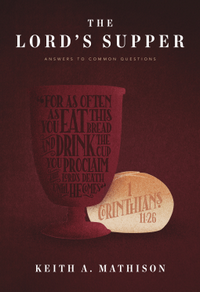 The Lord’s Supper: Answers to Common Questions
The Lord’s Supper: Answers to Common Questions
eARC, 99 pg.
Reformation Trust Publishing, 2019
Read: August 4, 2019

There were many laudable things about Mathison’s Given for You: Reclaiming Calvin’s Doctrine of the Lord’s Supper (P & R Publishing, 2002), one of the personal highlights was the final chapter, “Practical Issues and Debates.” This new release from Reformation Trust takes the same impulses that were behind that chapter (and the rest of the book) and delivers a concise introduction to the Reformed doctrine of the Lord’s Supper, looking at the doctrinal landscape, a survey of the relevant passages, and some pressing questions (both theological and practical) for those with little background in the Sacrament, or those who wish to have their understanding sharpened.
Because the chapter titles represent just what you get in this book, let me post them:
| 1. What Is the Lord’s Supper? 2. What Are the Different Views of the Lord’s Supper? 3. Why Did Jesus Institute the Lord’s Supper on the Passover? 4. What Did Jesus Mean When He Said, “This Is My Body” and “This Is My Blood of the Covenant”? 5. What Does Paul Teach concerning the Lord’s Supper in 1 Corinthians 10– 11? 6. Is Jesus Present In The Lord’s Supper? 7. Is the Lord’s Supper a Sacrifice? 8. What Are the Elements of the Lord’s Supper? 9. How Frequently Should the Lord’s Supper Be Observed? 10. How Should Believers Prepare for and Partake of the Lord’s Supper? 11. Should Children Partake of the Lord’s Supper? |
The first two chapters cover the ground that a lot of books on the subject do—every author (and reader) need to start with the basics in view, and Mathison handles a survey these ideas very capably.
Chapter 3 is honestly not something I’ve considered before (at least not in a lot of detail)—after all, when else could the Last Supper have been held? But I’m glad he covered this idea, and it gave me a good perspective on redemptive-historical place of the sacrament instituted that night.
Chapters 4 and 5 are very helpful and clear while guiding the reader through the passages in question. He doesn’t get too technical with the passages (due to space and the focus of the book), but is efficient enough in his explanation that he provides a solid grounding for further study and meditation. I particularly appreciated that in Chapter 5, Mathison is careful to point out that not only does the sacrament look back (“Do this in remembrance”), but it looks forward in eschatological hope to the consummation.
Chapter 6 is obviously going to be controversial and might cause problems for many. Mathison is irenic, yet he doesn’t waver from his position (or provide much wiggle room for those who might disagree). Carefully building on the aforementioned texts and the Niceno-Chalcedonian doctrine concerning the person of Christ, he then explains the teachings of the magisterial Reformers (the non-Lutheran ones, anyway) in a way relevant to today’s believer.
Like Chapter 6, Chapter 9 covers ground that he focused on in the longer previous work—and those who want more on those subjects have a ready resource in his work. What’s here is a great start, but it’s not everything Mathison has to say on the ideas.
Chapter 10 is pure gold, it’s one of the best things I’ve read this year. It’s helpful and encouraging (and, yes, a little challenging)—worth the purchase price alone.
Overall the writing is clear—easy enough for anyone to approach and understand, while not losing the depth and rigor necessary when dealing with something as important as this. Mathison cites other authors (contemporary and historical) to help (and the footnotes provide great fodder for further study), but shoulders most of the work himself. If you’ve never read Mathison, this is a good way to see one of his strengths is always taking complex ideas and presenting them in an accessible fashion.
I have two complaints—neither are enough to keep me from recommending the book, and possibly gifting it—but they’re things that bugged me. Brevity. It’s just too short, it doesn’t have to be as long as Given for You, but each chapter could be just a little longer and more developed.
The second complaint (semi-related) is the lack of a conclusion, just a page or two of wrap-up, an exhortation to use these answers—something. It just ends abruptly after Chapter 11*, and the absence of anything else was a deafening silence.
*There’s a bankruptcy joke begging to be made there, but it seems cheap.
Those a great resource for those with questions about the Reformed position on the sacrament. Like Guy Prentiss Waters’ The Lord’s Supper as the Sign and Meal of the New Covenant from last year, it’s a great introductory work and would make a great companion to it, the two would round out each other. Mathison helps to deal with practical and theoretical issues that young believers, or believers new to the Reformed tradition, stumble on and struggle with. Faithful, helpful, wise, and encouraging, this book is a great help and you’d do well to check it out.
Disclaimer: I received this eARC from Reformation Trust Publishing via NetGalley in exchange for this post—thanks to both for this, I appreciate the opportunity, but not enough to change my opinion of the book.
—–

![]()

